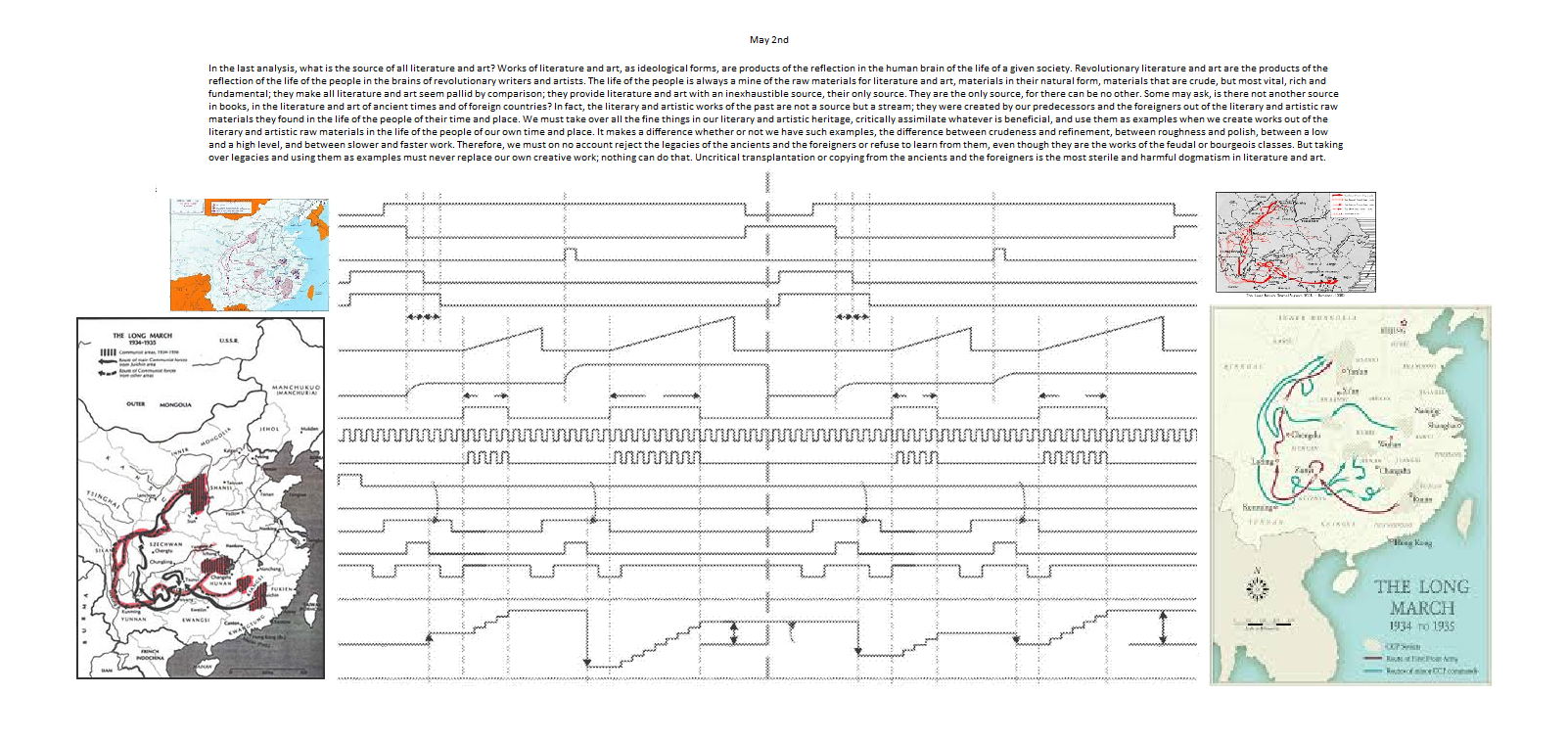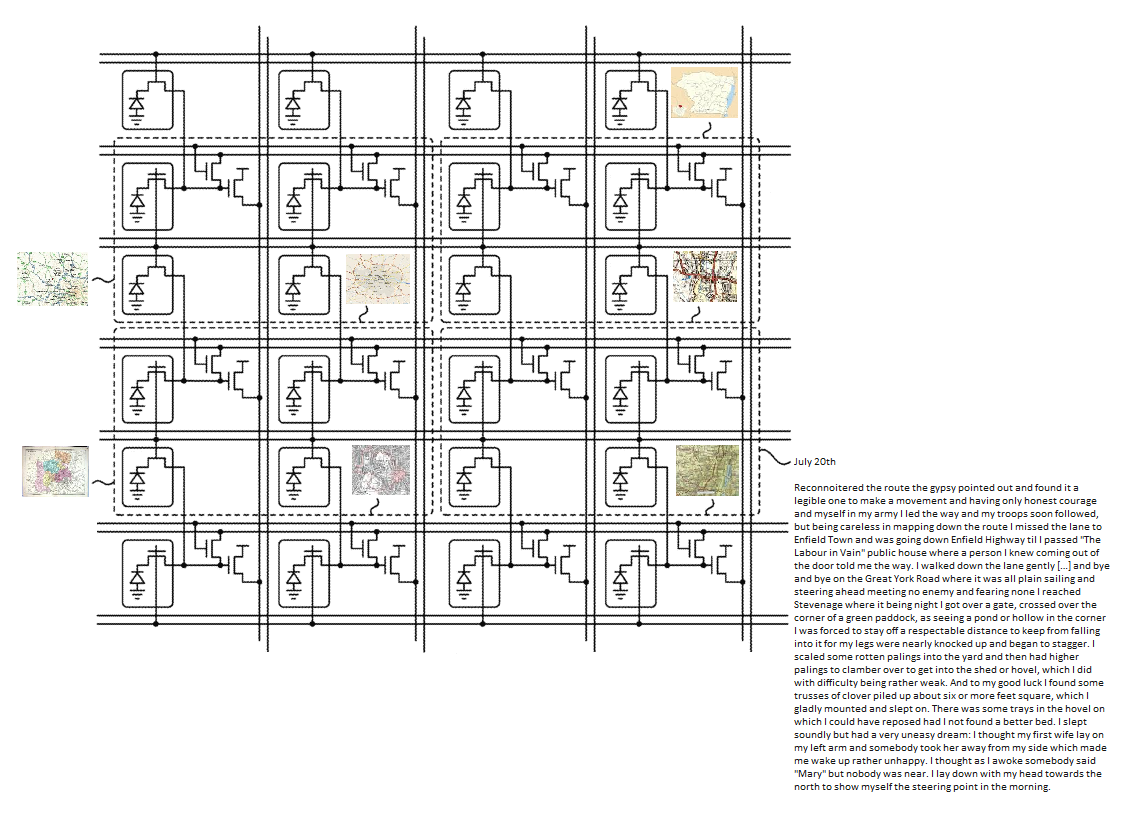Place Pending – A Mapping Bootcamp
My intentions with this mapping bootcamp were to simply continue the discussion of human presence detection systems that my probe initiated. As I mentioned in class, the HPDS ‘corpus’ exists mostly in the realm of the theoretical, and the race to patent hardware able to handle the task of realtime and multiscalar detection is currently one of the hotbeds of corporate research and design. This in mind, I figured that an intervention of literary mapping – or rather the appropriation of tools for literary mapping that would somehow intervene-at-a-distance – should occur at the level of the patent. I wanted to more deeply delineate Morreti’s “map of mentalite” and “map of ideology,” so I looked around for patented HPDS technologies that I could use for both, and I found one published in April of 2013: a plan for concurrent row readout within the high-speed integrated circuitry of the image sensor technology this patent’s parent company (Omnivision) is developing for medical, automotive and mobile purposes. Essentially, the patent is not showing us an object as such, but a conceptual mapping of the way the massive and massively variegated data sets relevant to HPD (body heat, physiognomy, affective movement, pressure sensing, all overlapping but not always mutual indicators of the human in the image) can be kept distinct and related within ongoing image capture.
Of course, I pretty much nothing about all of this. But I chose to work with two images from the patent, relating them to a dataset (a literary text) in the hopes of identifying the human in the unactualized HPDS, much as its actualized technology will eventually do with the dataset of its use. Here is the first attempt, entitled Enfield:
The text is a selection from the poet John Clare’s notebooks, detailing his escape from a mental asylum and fugue-like journey to reunite with his muse (in reality long dead) in Enfield. I have removed figural annotation of cicuit lacings (the way one row of readout can be related to another, in this case) and replaced them with a variety of common cartographies of Enfield and the surrounding area, from atlases to google maps. My hope was that this reworked image would show a map of mentalite, which I understand to refer to the passive and noncynical and nonlucid ways that an individual relates themselves to placebound processes. This portion of the patent describes an physical situation that has to be built within the HPDS, and is tied more to the role of memory, so I thought Clare’s Romanticism (and his context as a pastoral poet who became fashionable for a time in the cities, one kind of memory readout among many within the capitalist circuitry) was fitting.
Here is the second attempt, entitled Yenan:
 This text comes from Mao Tse-Tung’s “Talks at the Yenan Forum on Literature and Art,” which took place after the Long March and was a landmark statement of the unique stance on social realism that would characterize China from then until now. Basically Mao is calling not just for a proletarian takeover of elitist traditions (he happened to write poetry, and only in the classical forms he disdained), but a preservation and dissemination of the logic of those traditions, a slow elevation of the masses to the heights of literary specialization held formerly by bourgeois scholars alone. In this case I wanted to put the map of ideology into relief, in the sense that there is an opposing lucidity and cynicism about of the mechanisms of social memory (as Yenan was turned into a conceptual map for the People’s Republic), which simultaneously harvests and produces mentalite. Likewise, the template I used is the inverse of the first: rather than a possible object, it is a possible relation of objects, or rather subjugation, since this figure explains how the various datasets are parsed and trimmed in the hunt for human presence.
This text comes from Mao Tse-Tung’s “Talks at the Yenan Forum on Literature and Art,” which took place after the Long March and was a landmark statement of the unique stance on social realism that would characterize China from then until now. Basically Mao is calling not just for a proletarian takeover of elitist traditions (he happened to write poetry, and only in the classical forms he disdained), but a preservation and dissemination of the logic of those traditions, a slow elevation of the masses to the heights of literary specialization held formerly by bourgeois scholars alone. In this case I wanted to put the map of ideology into relief, in the sense that there is an opposing lucidity and cynicism about of the mechanisms of social memory (as Yenan was turned into a conceptual map for the People’s Republic), which simultaneously harvests and produces mentalite. Likewise, the template I used is the inverse of the first: rather than a possible object, it is a possible relation of objects, or rather subjugation, since this figure explains how the various datasets are parsed and trimmed in the hunt for human presence.
In class I mentioned that I believe this bootcamp failed, but I think I should resist editorialization and just leave these prototypes as they are. At present I’m viewing them more as visual poetry than textual analyses.

